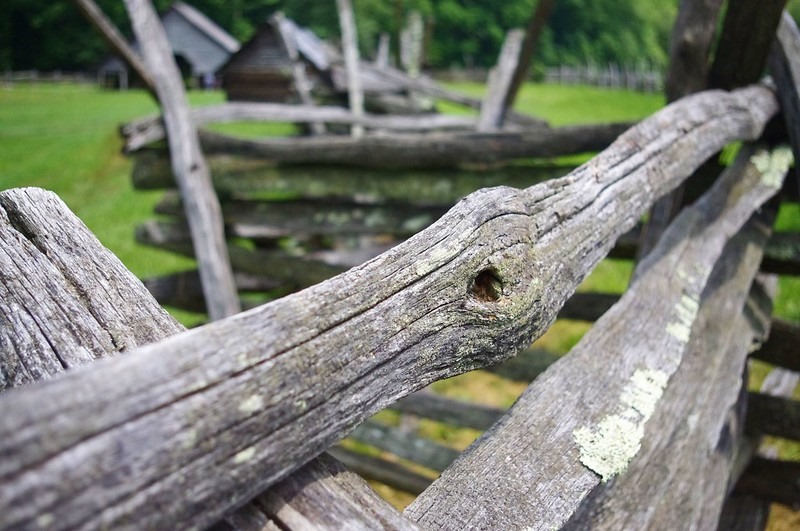Royalty-free images by Mike1 — No. 96 of over 1200 images

Mountain Farm Museum, Great Smokey Mountains National Park, North Carolina, June 15, 2012
Mountain Farm Museum2
The Mountain Farm Museum (in Great Smoky Mountains National Park, near Cherokee, North Carolina) is a unique collection of farm buildings assembled from locations throughout the park. Visitors can explore a log farmhouse, barn, apple house, springhouse, and a working blacksmith shop to get a sense of how families may have lived 100 years ago. Most of the structures were built in the late 19th century and were moved here in the 1950s. The Davis House offers a rare chance to view a log house built from chestnut wood before the chestnut blight decimated the American Chestnut in our forests during the 1930s and early 1940s. The museum is adjacent to the Oconaluftee Visitor Center.
The site also demonstrates historic gardening and agricultural practices, including livestock.
Split-rail fence3
A split-rail fence or log fence (also known as a zigzag fence, worm fence or snake fence historically due to its meandering layout) is a type of fence constructed in the United States and Canada, and is made out of timber logs, usually split lengthwise into rails and typically used for agricultural or decorative fencing. Such fences require much more timber than other types of fences, and so are generally only common in areas where wood is abundant. However, they are very simple in their construction, and can be assembled with few tools even on hard or rocky ground. They also can be built without using any nails or other hardware; such hardware was often scarce in frontier areas. They are particularly popular in very rocky areas where post hole digging is almost impossible. They can even be partially or wholly disassembled if the fence needs to be moved or the wood becomes more useful for other purposes. During the American Civil War, these split rail fences were a major source of firewood for both the Union and Confederate armies.
Split rail fences were made of easy to split, rot-resistant wood. Traditionally American chestnut was the timber of choice until chestnut blight eliminated this tree. Currently, most split rails are made from cedar. Whether of chestnut or cedar, these logs were cut to a length of 10 to 12 feet (3.0 to 3.7 m) and split down the length of the log. Each half was then split into quarters, then eighths and so on until the rails were of a usable size. A log may produce from four rails from an 8-inch (20 cm) log to over a dozen from larger logs. The rails are stacked on top of one another. Most split rail fences have the rails stacked in an interlocking zig-zag fashion that is self-supporting, easy to create, easy to repair, and easy to disassemble.
Some timber fences have the rails stacked directly on top of each other and secured with double fence posts (one on either side of the rails). This made a more permanent and compact fence but remained easy to repair.
The distance between either the zigs or the zags is generally 16.5 feet (5 m) or one rod. The area of a field can therefore be calculated by counting zigs or zags along the side and end of the field: one hundred sixty square rods is 1-acre (0.40 ha).
- I am sharing some of my public domain images in periodic blog posts.
- Mountain Farm Museum – National Park Service
- Split-rail fence – Wikipedia
Notes:
- This image is also shared as public domain on Pixabay, Flickr, and Pinterest.
- Images are being shared in the sequence they were accepted by Pixabay, a royalty-free image sharing site.
- Only images specifically identified as such are public domain or creative commons on our pages.
- All other images are copyright protected by me, creative commons, or used under the provisions of fair use.

